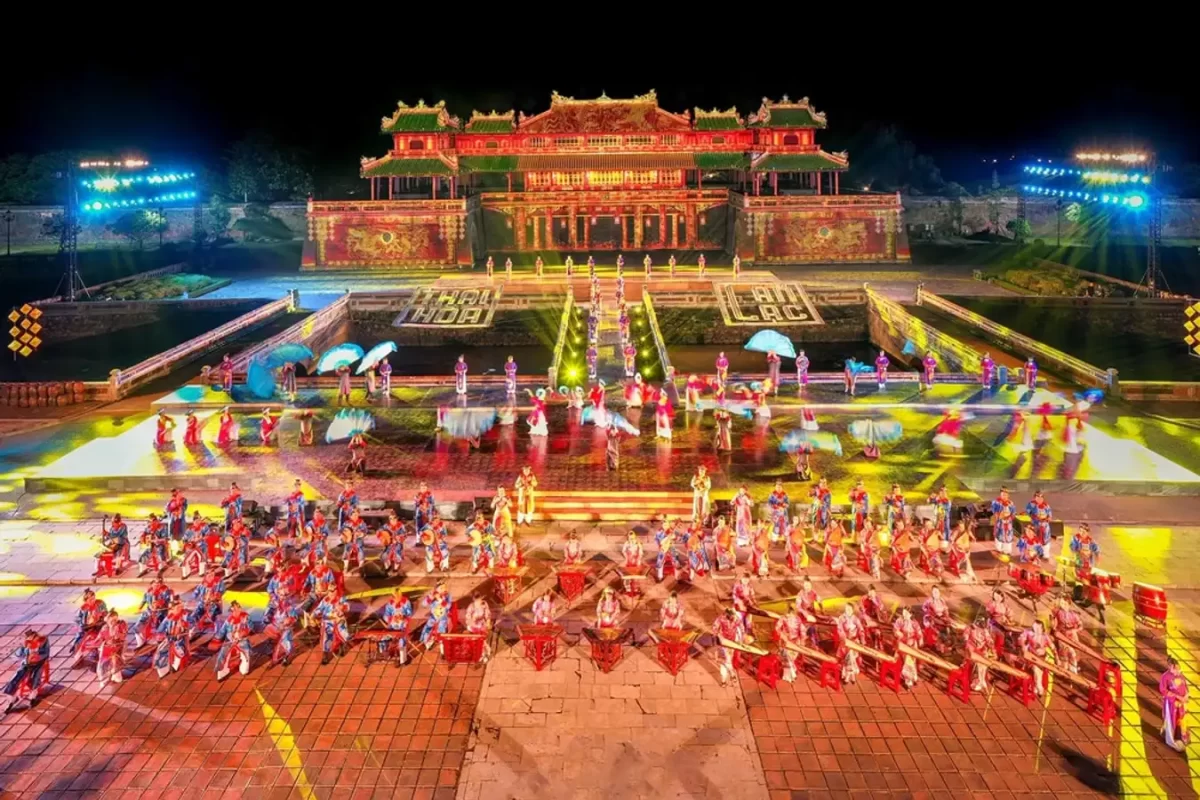The Hue Imperial City is a famous tourist destination and a masterpiece of architectural beauty from the Nguyen Dynasty during the feudal era. Visiting the Hue Imperial City, tourists will not only admire the unique architectural works but also have the opportunity to participate in various exciting tourism activities.
Introduction to the Hue Imperial City
The Hue Imperial City is considered a highly valuable architectural and cultural landmark of the nation. It is the second innermost enclosure within the Hue Citadel. This massive complex once served the purpose of protecting the essential palaces of the imperial court—a restricted area reserved only for the king and the royal family. When combining the Royal City (Hoàng Thành) and the Forbidden Purple City (Tử Cấm Thành), it is referred to as the Imperial City (Đại Nội).
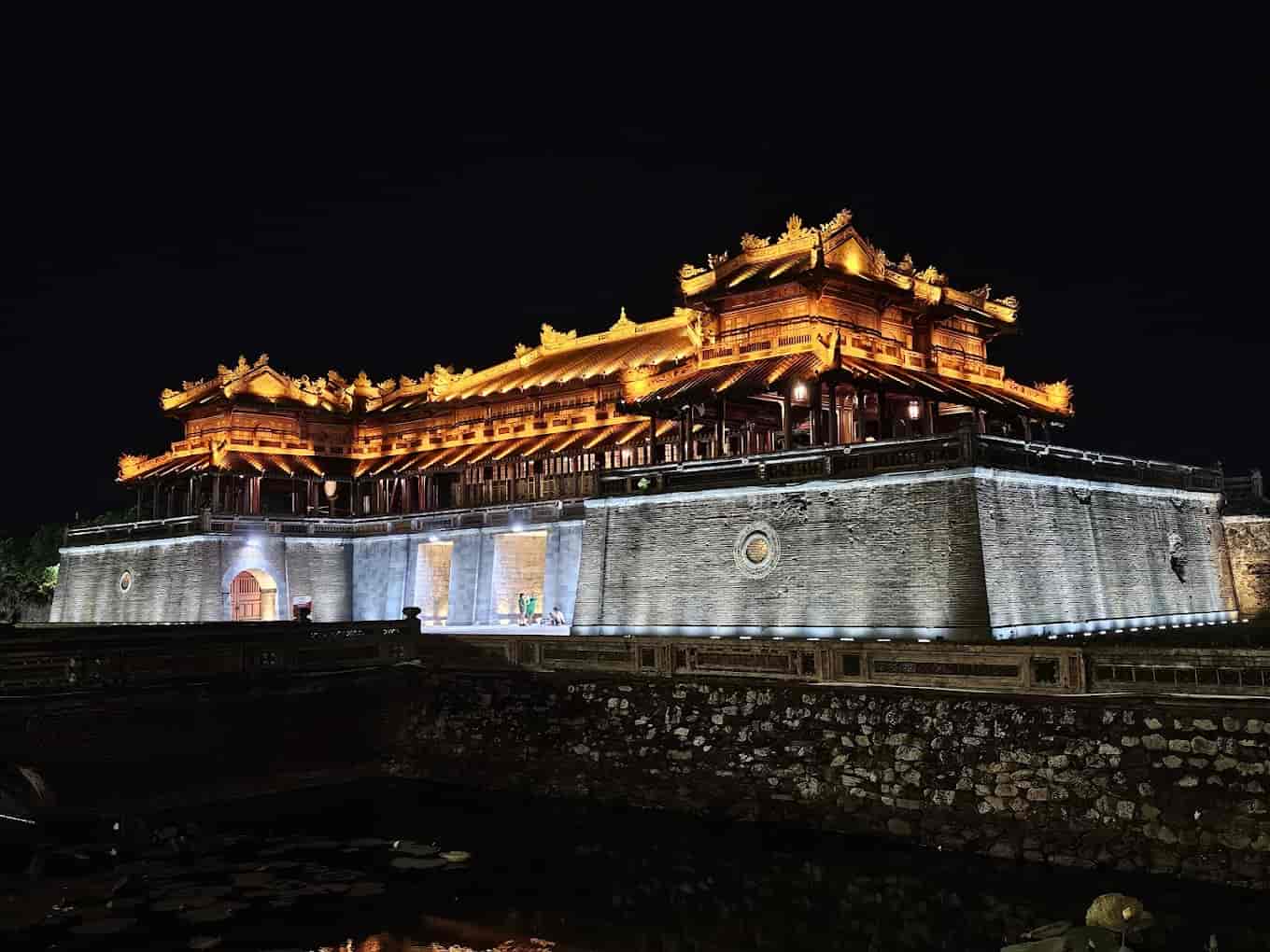
The Imperial City was constructed hundreds of years ago and was once the living quarters of the king and the royal family. The structure boasts a spacious layout, divided into several distinct layers. The arrangement of areas such as ponds, lakes, and royal gardens is exceptionally harmonious and well-planned.
The Hue Imperial City houses more than 100 magnificent architectural structures, including the Noon Gate (Ngọ Môn), Dien Tho Palace (Cung Diên Thọ), the Forbidden Purple City (Tử Cấm Thành), and Thai Hoa Palace (Điện Thái Hòa). Visitors here will also have the opportunity to glimpse into the glorious past of our nation. All the artifacts and traces of the past have been meticulously preserved, serving as remnants of the country’s prosperous feudal era. Everything is vividly displayed, leaving an enduring mark through time.
If you have the chance to visit Hue, take some time to fully explore the magnificent scenery and unique architectural works of the Hue Imperial City.
Location of the Hue Imperial City
The Hue Imperial City is an important part of the Hue Citadel Complex, located on the banks of the Perfume River. Today, this scenic spot is situated in Phu Hau Ward, right in the center of Hue city.
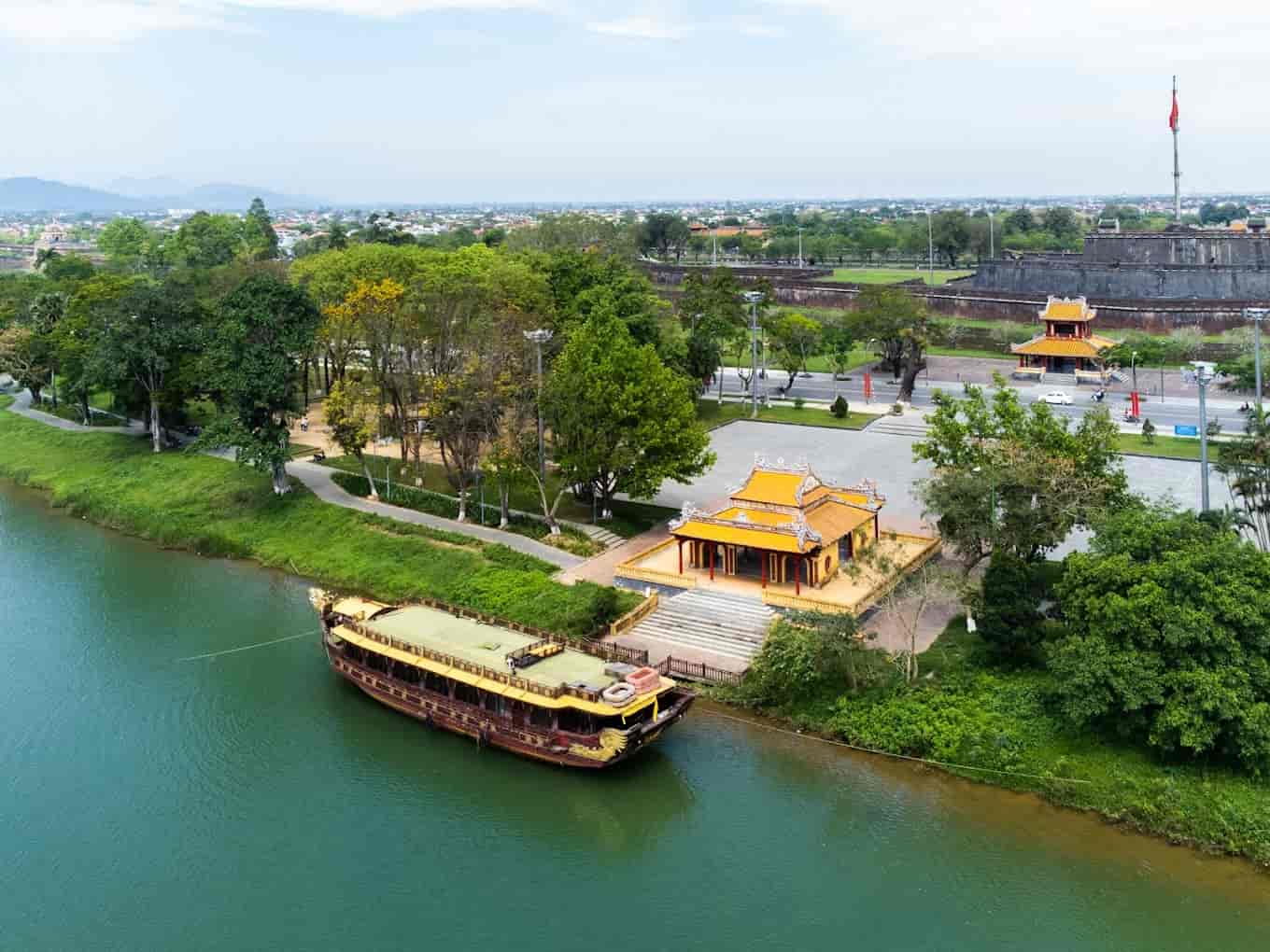
When is the best time to visit the Hue Imperial City?
Hue is a year-round tourist destination, and you can visit at any time to experience many exciting activities. However, the best time to visit is in April or June during even-numbered years. This is when lively festivals and activities take place in Hue and at the Imperial City.

Additionally, if you plan to visit the Imperial City, try to go in the morning to enjoy the fresh air of Hue. Another small tip: if you want to explore the entire Imperial City without worrying about closing time, you should visit in the early afternoon.
Check out the detailed article on the best time to visit Hue: “Best Time to Visit Hue: When to Experience the Most Beautiful and Enjoyable Seasons.
How to get to the Hue Imperial City?
Starting from the center of Hue city, you can take a motorbike along the southern bank of the Perfume River to Trang Tien Bridge or Phu Xuan Bridge, continue through Bach Ho, and follow Quang Duc Street to reach the Imperial City. If you are traveling with a group or have children, taking a taxi is also an option, as taxi fares in Hue are quite affordable.
Most international tourists often visit Da Nang or Hoi An first, and then look for a trip to the Hue Imperial City and other attractions such as royal tombs, Thien Mu Pagoda, etc. To ensure a quick, private, safe, and comfortable trip, the day trip service from Da Nang to Hue by private car offered by HueTransferService.com is the best choice. Our English-speaking driver will pick you up at your hotel in Da Nang or Hoi An, and along the way, you can stop to visit sites like Hai Van Pass, Lap An Lagoon, etc. After arriving in Hue, you can explore attractions such as the Hue Imperial City, and then our driver will take you back to your hotel in Da Nang or Hoi An. You can also book a one-way trip from Da Nang to Hue by private car with us.
How long does it take to explore the Hue Imperial City?
The scale of the Hue Imperial City is vast. To leisurely explore, enjoy the sights, and take photos of all the beautiful scenes here, you will need about half a day.
In addition to sightseeing, visitors can participate in many engaging activities such as tea tasting, listening to music, and more. All of these will make your trip even more enjoyable.
Entrance fees and opening hours of the Hue Imperial City
Opening Hours
- Summer: 6:30 AM – 5:30 PM
- Winter: 7:00 AM – 5:00 PM
Entrance Fees
Here is the latest ticket price list. The prices are not too expensive and are quite suitable for the budget of many young travelers.
- Adults: 120,000 VND/person
- Children: 30,000 VND/person
- Foreign tourists: 150,000 VND/person
The above ticket prices include entry to both the Hue Imperial City and the museum area.
Read more about the most detailed article on entrance fees in Hue: Entrance Fees for Attractions in Hue 2024 | Updated Admission Prices.
History of the Formation of the Hue Imperial City
In the history of Vietnam, the Hue Imperial City is considered the most massive and extensive structure. To build this historical site, the imperial court had to mobilize tens of thousands of workers. The construction took a total of 30 years to complete.
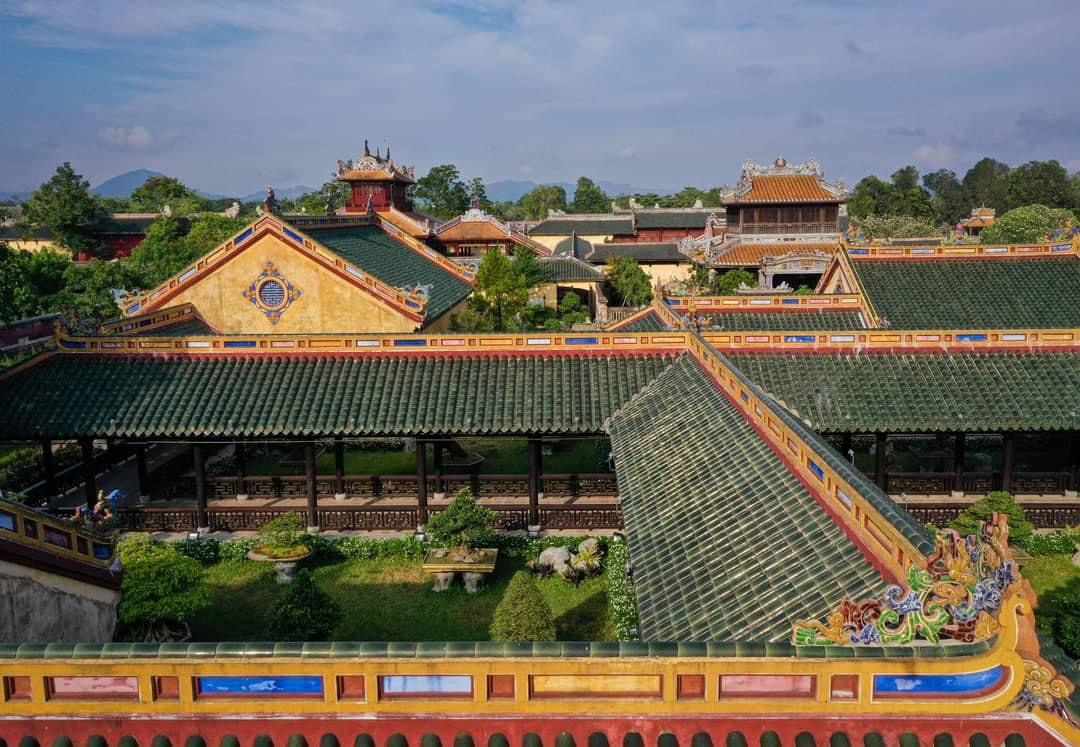
In 1802, after ascending to the throne, Emperor Gia Long designated Hue as his capital. He conducted a survey to select the site for constructing the citadel complex. The purpose of the construction was to serve as a meeting place for the imperial court and as the royal family’s residence. The construction of the Citadel, including the Imperial City, began in 1804 but was not completed until 1833, during the reign of Emperor Minh Mang.
Exciting Experiences at the Hue Imperial City
Explore the Hue Imperial City by Cyclo
One of the most enjoyable experiences you must try when visiting the Hue Imperial City is taking a cyclo to explore every corner. This is a great option for those who are tired of walking or feeling a bit fatigued after a long journey. Additionally, many tourists choose this service to save time and make their tour of the Imperial City as short as possible.
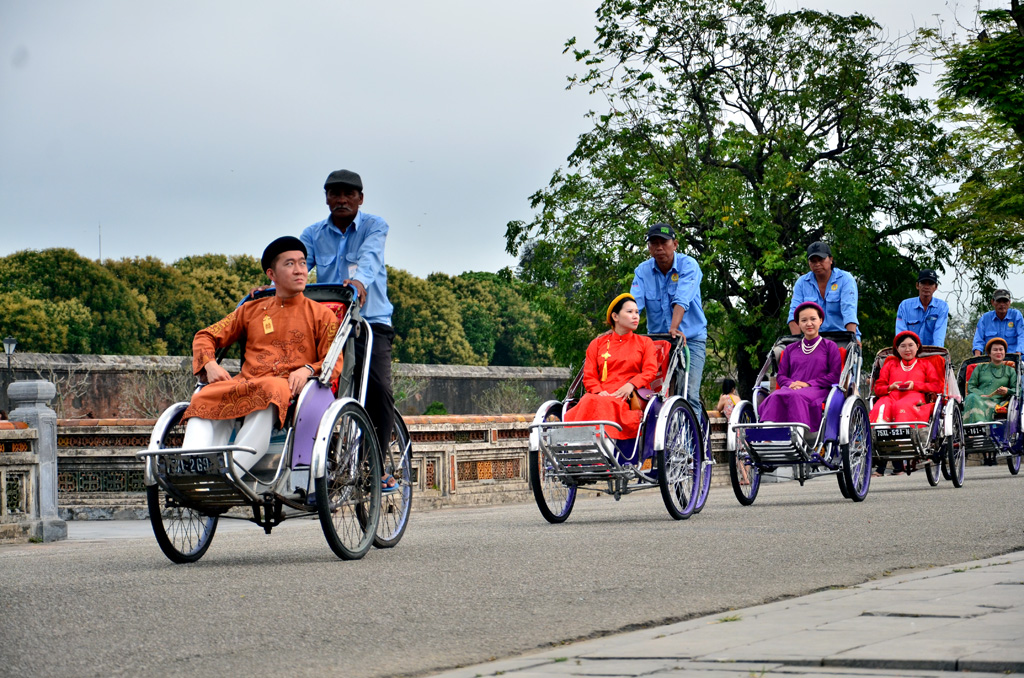
The cost of a cyclo ride ranges from 20,000 to 30,000 VND. Moreover, using this mode of transportation ensures that you won’t get lost or take a wrong turn on your way back.
Visit the Entire System of Tombs and Palaces at the Hue Imperial City
The Imperial City houses many magnificent tombs and palaces, so when you visit, make sure to explore these structures to appreciate the unique craftsmanship of Vietnamese architecture from the past.
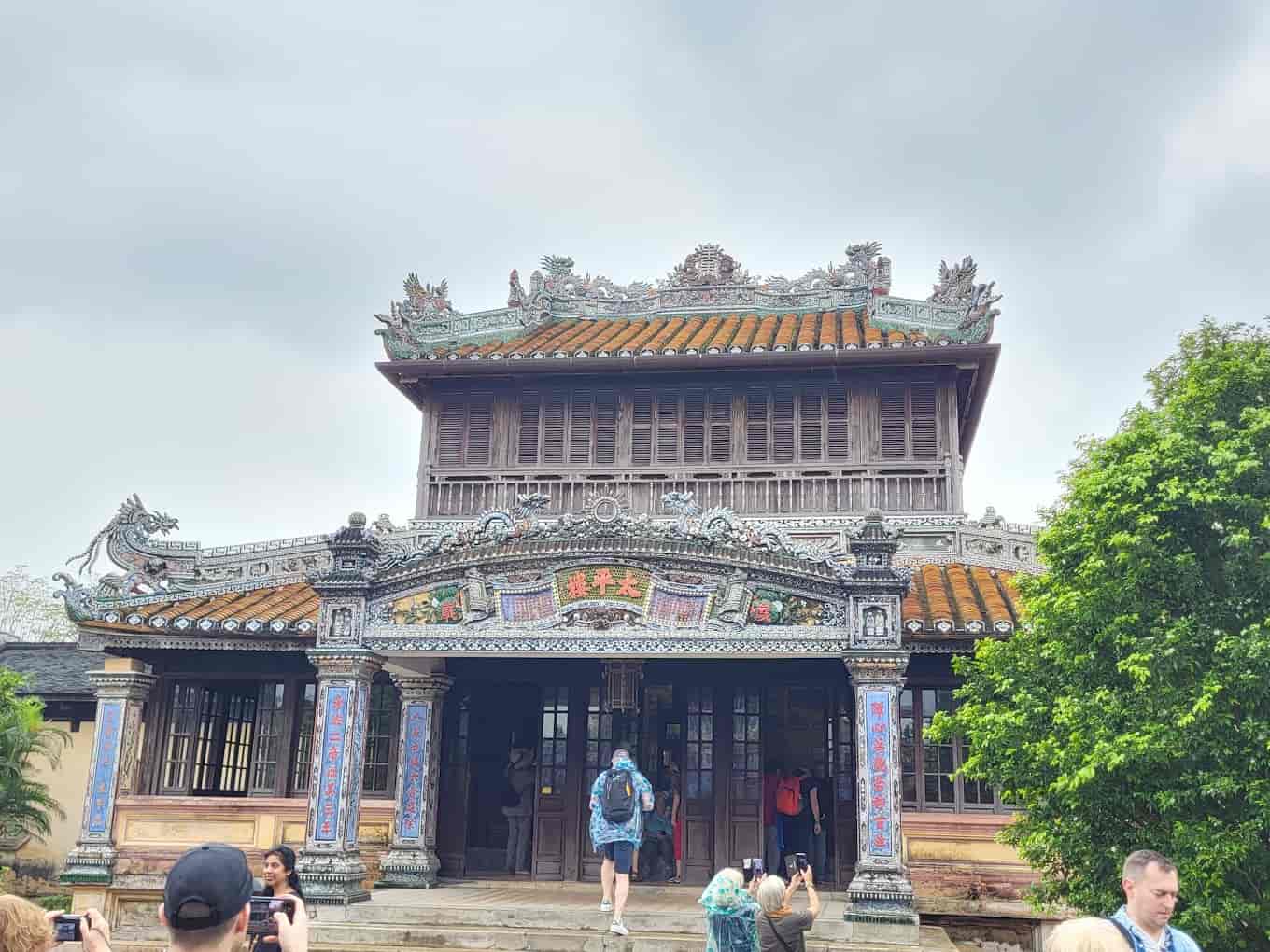
Enjoy the Stunning Night View of the Hue Imperial City
The ideal time to visit the Imperial City is during the day. However, the square outside the Imperial City at night also attracts many visitors who come to enjoy the radiant beauty of the Imperial City. As night falls, a multitude of colorful lights illuminate the scene, resembling an ancient Chinese town in the heart of Hue. This is the perfect time to take some beautiful photos as souvenirs.
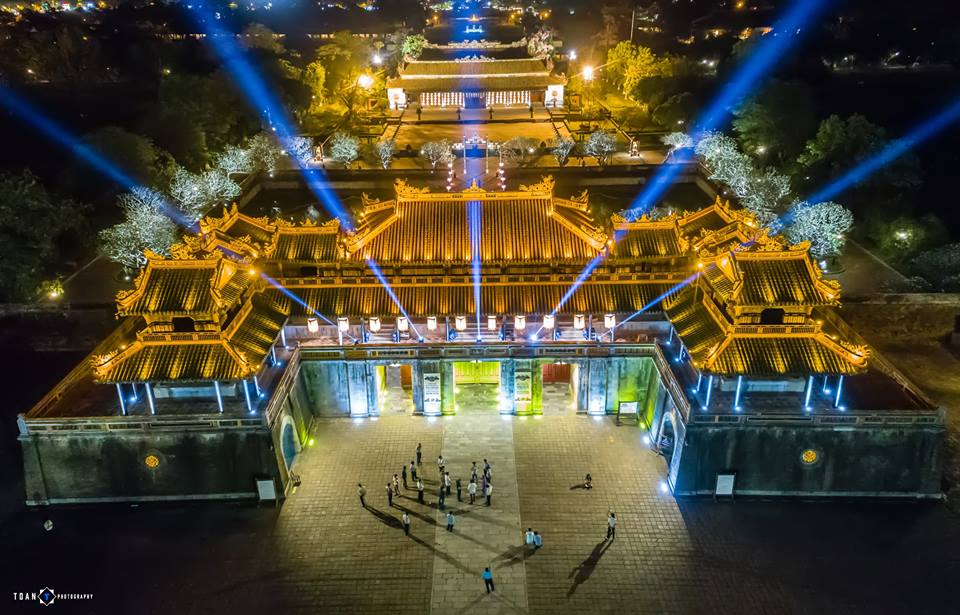
Enjoy Tea at Dien Tho Palace
At Dien Tho Palace, visitors can partake in a unique activity: enjoying tea in the garden courtyard. The serene and poetic atmosphere, combined with the delightful flavors of various teas, brings a deep sense of peace to everyone. This is a refined and enjoyable experience that you should definitely try when visiting the Imperial City.

Participate in Royal Festivals
If you have the opportunity to visit the Imperial City during festival season, consider yourself lucky. The atmosphere here during festivals is always vibrant and bustling with spectacular performances. This will undoubtedly be a highlight of your visit to the Imperial City.
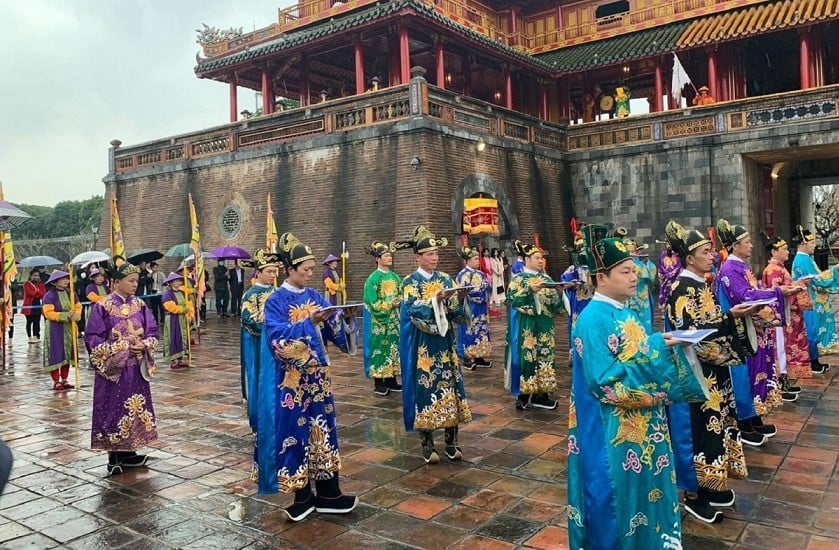
Attractions at the Hue Imperial City
Ngo Mon Gate
Ngo Mon is the main southern gate of the Hue Royal Citadel. The structure consists of two main parts: the gate platform and the Ngu Phung Pavilion. The gate is built in a U-shape with five entrances. The central passage is reserved for the king, while the two side passages, Huu Giap Mon and Ta Giap Mon, are for the mandarins of the court. The outermost passages are for soldiers and horses.

Above the gate is the Ngu Phung Pavilion, supported by 100 ironwood pillars with extremely intricate details. To this day, Ngo Mon remains a symbol of the peak of intelligence and craftsmanship of the Vietnamese people. When visiting Hue, be sure to check in at the Ngu Phung Pavilion to capture the most beautiful moments.
The Forbidden Purple City (Tử Cấm Thành)
The Forbidden Purple City is a vital part of the overall architecture of the Hue Imperial City. This relic is located on the north-south axis with the Citadel and the Royal Citadel, forming a wall surrounding palaces such as Can Chanh Palace, Can Thanh Palace, Khon Thai Palace, and Kien Trung Palace.
Thai Hoa Palace
Thai Hoa Palace is a prominent tourist attraction at the Hue Imperial City. In the past, this was where all 13 emperors of the Nguyen Dynasty were crowned. It was also the site of many significant events such as the king’s birthday, the reception of foreign ambassadors, and grand court ceremonies.
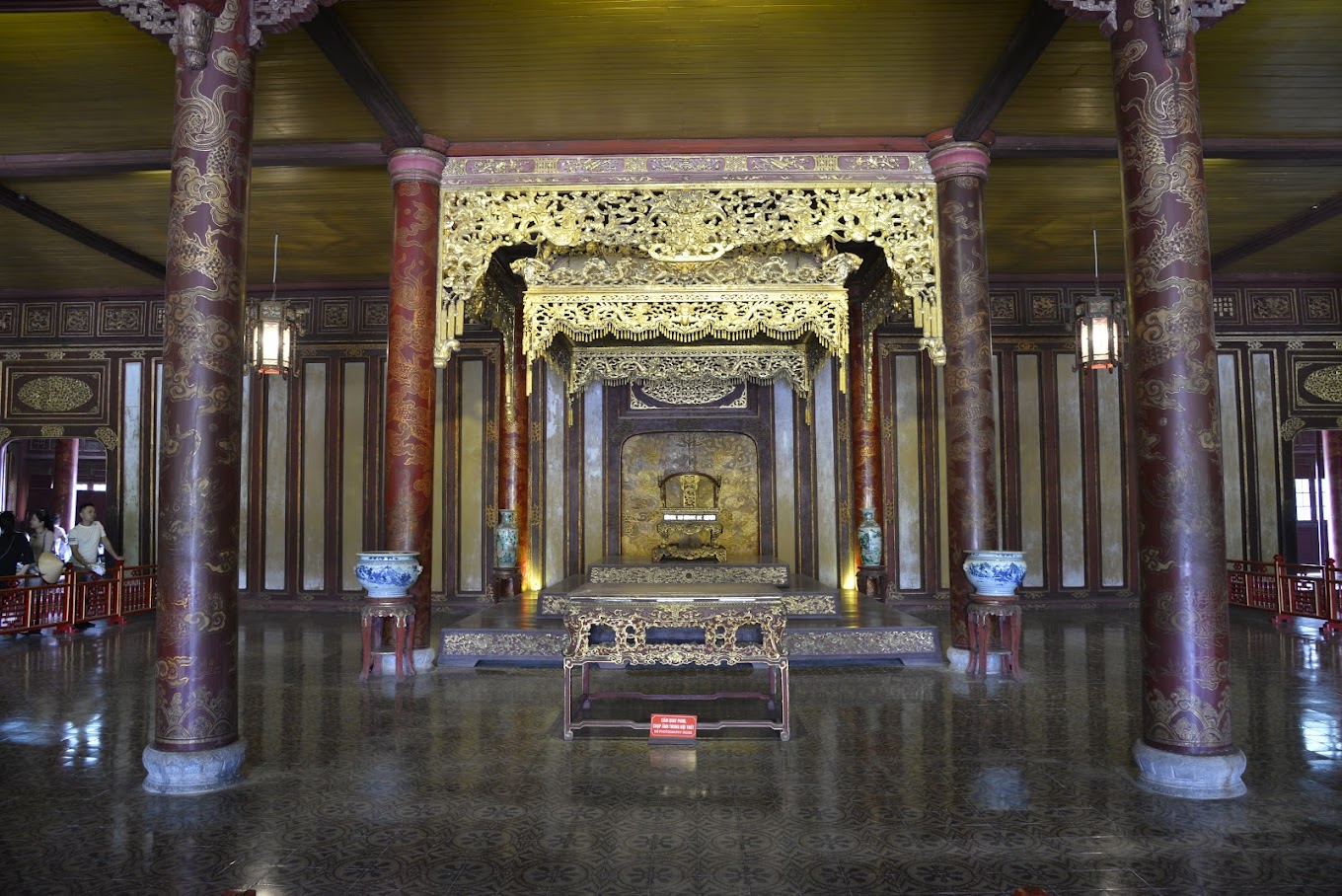
The name “Thai Hoa” reflects the Nguyen emperors’ wish for a peaceful and prosperous country and a thriving dynasty.
Dien Tho Palace and Truong Sanh Palace
Dien Tho Palace was built in 1803 as the residence and living quarters for the Queen Mother. The palace symbolizes longevity and prosperity for the Queen Mother.
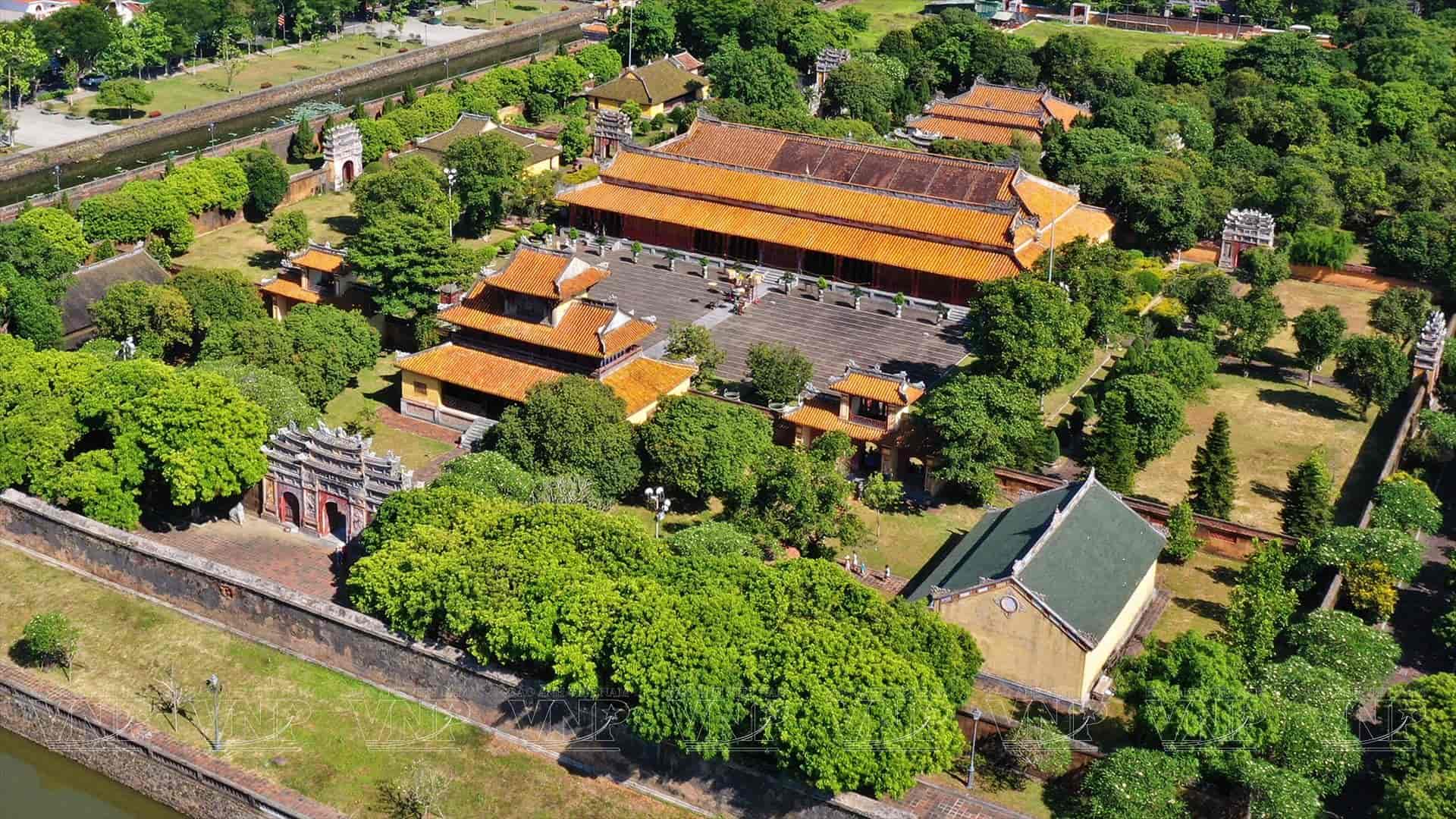
The palace is set amidst a tranquil natural landscape, with a pond, goldfish, lotus flowers, and a resting place for visitors. It offers a rare and peaceful scene that is hard to find in bustling urban areas.
Kien Trung Palace
Kien Trung Palace is not only a major and significant architectural structure within the Forbidden Purple City (Hue) but also holds many historical landmarks of the country. It served as the working and living quarters for the last two emperors of the Nguyen Dynasty, Emperor Khai Dinh and Emperor Bao Dai. Kien Trung Palace is also known as the place where Emperor Khai Dinh passed away (November 6, 1925) and where Empress Nam Phuong (wife of Emperor Bao Dai) gave birth to Crown Prince Bao Long (January 4, 1936).

Duyet Thi Duong Theater
Duyet Thi Duong is a rectangular theater with impressive curved eaves on the roof. The building is supported by 12-meter-high ironwood pillars. This structure consists of two levels and is where royal court music performances frequently took place.

Some Notes When Visiting the Hue Imperial City
Dress Appropriately
When visiting the Hue Imperial City, avoid wearing inappropriate clothing or posing in a disrespectful manner. This shows a lack of respect for a place of historical and cultural significance that has endured for thousands of years.
Another note is that you are not allowed to take photos or videos of the interiors, and you must not touch any of the artifacts.
Study the Map
If you are planning a visit to the Hue Imperial City soon, take some time to review the map, routes, and locations of the sites you want to visit to avoid getting lost during your trip. Given the vast area, having this guide is something you should definitely keep handy.
Maintain Cleanliness
When visiting the Hue Imperial City, be mindful of keeping the area clean and preserving the beauty of the site by not littering. There are many trash bins along the pathways, so it would be quite disappointing to see anyone throwing trash outside of them, right?
After enduring the ups and downs of history, the Hue Imperial City still stands tall in the heart of the ancient capital. This historical site also serves as a testament to the existence and decline of Vietnam’s last feudal dynasty. Besides its historical significance, the Imperial City continues to be a cornerstone for Hue’s tourism, helping it reach new heights.

